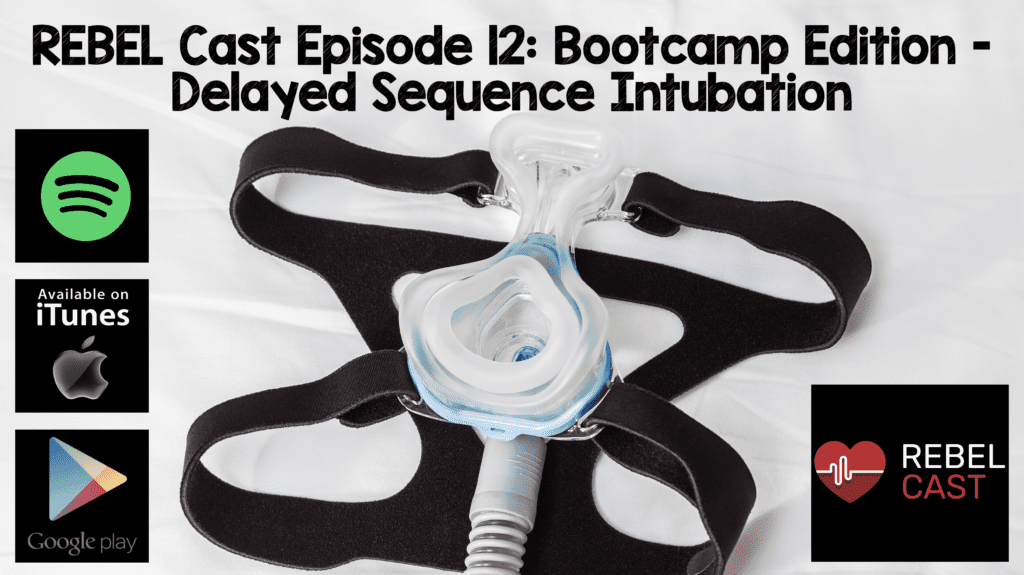
 Welcome back to a special edition, or should I say “bootcamp edition” of REBELCast. We have started to do something new by inviting guests onto the show to discuss papers in the literature they find interesting. This month I had the pleasure of working with Steve Carroll, an emergency room physician in my neck of the woods, down in San Antonio, TX. Today, Steve and I are going to specifically discuss how to manage the hypoxic and agitated patient, and the topic we are discussing:
Welcome back to a special edition, or should I say “bootcamp edition” of REBELCast. We have started to do something new by inviting guests onto the show to discuss papers in the literature they find interesting. This month I had the pleasure of working with Steve Carroll, an emergency room physician in my neck of the woods, down in San Antonio, TX. Today, Steve and I are going to specifically discuss how to manage the hypoxic and agitated patient, and the topic we are discussing:
Delayed Sequence Intubation (DSI) of the Hypoxic and Agitated Patient
REBEL Cast 12: Bootcamp Edition – Delayed Sequence Intubation
Click here for Direct Download of Podcast
Who is our guest this month on REBELCast?
 Our guest this month is Steve Carroll, DO (Twitter: @embasic) who has a fantastic podcast of his own called EM Basic. EM Basic is a project Steve started almost 4 years ago, with his focus on teaching the basics of emergency medicine. Since he is affiliated with the army, the tagline of “Your Boot Camp Guide to emergency medicine,” seemed like a perfect fit. After almost 4 years, he now has 65 episodes and planning on making more. And for those of you who have not heard of EM Basic you should definitely check it out. Steve is on the cutting edge of using podcasting to teach core content of materials about things like chest pain, abdominal pain, and more. If you are a 3rd or 4th year medical student interested in emergency medicine or an intern practicing emergency medicine be sure to check out EM Basic.
Our guest this month is Steve Carroll, DO (Twitter: @embasic) who has a fantastic podcast of his own called EM Basic. EM Basic is a project Steve started almost 4 years ago, with his focus on teaching the basics of emergency medicine. Since he is affiliated with the army, the tagline of “Your Boot Camp Guide to emergency medicine,” seemed like a perfect fit. After almost 4 years, he now has 65 episodes and planning on making more. And for those of you who have not heard of EM Basic you should definitely check it out. Steve is on the cutting edge of using podcasting to teach core content of materials about things like chest pain, abdominal pain, and more. If you are a 3rd or 4th year medical student interested in emergency medicine or an intern practicing emergency medicine be sure to check out EM Basic.

What clinical question will be covered in REBELCast Bootcamp Edition?
Question: Is DSI a safe and effective alternative to RSI in patients who cannot be adequately pre-oxygenated?
What specific article will we be covering?
Article: Weingart et al. Delayed Sequence Intubation: A Prospective Observational Study. Ann Emerg Med 2015; 65(4): 349 – 55. PMID: 25447559
Background: Delayed Sequence Intubation or DSI for short is a concept that Scott Weingart from the EmCrit podcast developed in order to safely intubate patients who are hypoxic, delirious, or combative. Since we cannot adequately pre-oxygenate these patients they are at high risk for hypoxia, dysrhythmias, anoxic brain injury, and even death. The concept of DSI is that it is procedural sedation for the purposes of pre-oxygenation. DSI is most useful for those patients who cannot tolerate pre-oxygenation with either high flow nasal cannula and non-rebreather or non-invasive ventilation.
Details:
- Population: Adult ED patients >18 years of age requiring emergency airway management and not predicted to have an anatomically difficult airway
- Intervention: Delayed Sequence Intubation (DSI)
- Comparison: Rapid Sequence Intubation (RSI)
- Outcome: Difference in Oxygen Saturations after maximal attempts at preoxygenation before DSI compared with saturations just before intubation
Results:
- 64 adult patients were enrolled (2 were excluded due to incomplete pulse oximetry data)
- 19 patients received DSI with a non-rebreather (NRB)
- 39 patients received DSI with a non-invasive positive pressure ventilation (NIPPV)
- 4 patients required nasogastric tube placement
- The oxygen saturations increased from a mean of 89.9% pre-DSI to 98.8% after DSI (Absolute increase of the oxygen saturation of almost 9%)
- Zero complications were observed in patients receiving DSI
Strengths:
- Multi-center study which allows demonstration that hospitals outside of the author’s own institution can make DSI work safely
Weaknesses:
- This was a small study of only 62 patients and a convenience sample, which means some patients could have been missed
- This was an observational study, which draws inferences about the effect of an “exposure,” in this case DSI. But it is important to mention that confounding factors may be the reason a given result occurred.
- Authors of this paper have experience and interest in DSI, which could cause a Hawthorne effect
- No children were used in this study, so makes it hard to extrapolate the results to a pediatric population
What is the clinical bottom line for the above clinical question:
Bottom Line: DSI is a safe and effective method of intubation while the purists would argue that a RCT is warranted, this practice should be widely adopted and considered for any patient who cannot be adequately pre-oxygenated prior to intubation.
The post REBEL Cast Episode 12: Bootcamp Edition – Delayed Sequence Intubation appeared first on REBEL EM - Emergency Medicine Blog.
